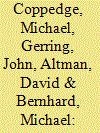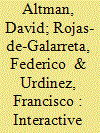|
|
|
Sort Order |
|
|
|
Items / Page
|
|
|
|
|
|
|
| Srl | Item |
| 1 |
ID:
105243


|
|
|
|
|
| Publication |
2011.
|
| Summary/Abstract |
In the wake of the Cold War, democracy has gained the status of a mantra. Yet there is no consensus about how to conceptualize and measure regimes such that meaningful comparisons can be made through time and across countries. In this prescriptive article, we argue for a new approach to conceptualization and measurement. We first review some of the weaknesses among traditional approaches. We then lay out our approach, which may be characterized as historical, multidimensional, disaggregated, and transparent. We end by reviewing some of the payoffs such an approach might bring to the study of democracy.
|
|
|
|
|
|
|
|
|
|
|
|
|
|
|
|
| 2 |
ID:
178716


|
|
|
|
|
| Summary/Abstract |
Democracies do not take up arms against each other. Although this axiom has attained the status of a mantra in the field of international relations, this statement is much more complex than it appears, in part because it is highly contingent on the definitions and operationalizations of both democracy and conflict. This article revisits democratic peace theory, combining both institutional constraints and similarity-based arguments. Interactions between the democratic level of the dyad (the average democratic level of its members) and its democratic spread (difference between the democratic scores of its members) create a dyadic triangle that encompasses all possible combinations of cases, revisiting which dyads are more prone to conflict. The findings partially confirm and partially refute both the institutional constraints and the similarity-based arguments, leading to a nuanced alternative theory: the Interactive Model of Democratic Peace. Akin to democratic peace theory, our evidence shows that the higher a dyad’s level of democracy is, the lower the probability of fatal militarized interstate disputes between that pair of states. However, contrary to democratic peace theory, we find that dissimilar-regime dyads can still be peaceful as long as they have a high mean of democracy. Following the theory of regime similarity, we consider the democratic spread of each dyad, but we find that being similar is not a sufficient condition for peace between the members of a dyad. From the empirical evidence, the article derives three heuristic zones of conflict, filling much of the gray area that has been left unexplained by previous models.
|
|
|
|
|
|
|
|
|
|
|
|
|
|
|
|
|
|
|
|
|